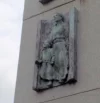For
alfarético, see footnote 5 in the
text. See also related common life-threatening pregnancy complications, many of them treatable or preventable these days, such as
pre-eclampsia and
eclampsia. Eclampsia is the onset of seizures, mostly during the second half of pregnancy and it can be followed by coma, cerebral haemorrhage and other fatal outcomes for a pregnant woman.
It is not possible to know what exactly led to the sudden severe illness and death of the pregnant peregrina registered in the books of the hospital/hostel in Bezantos in 1739 as widow Isabel from the town of Lucerne (Luzern) in the German-speaking part of Switzerland.
PS: 1739 ... that's over 200 years after the Reformation and a time when the pilgrimage from Europe to Saint James in Galicia was long past its heydays, partly because large parts of Europe that had become Protestant would no longer send people on pilgrimage, and when you think Switzerland, you think of the reformer Calvin. It was interesting to read on Wikipedia that
during the Reformation Lucerne remained attached to Roman Catholicism, of which ever since it has been the great stronghold in Switzerland.















